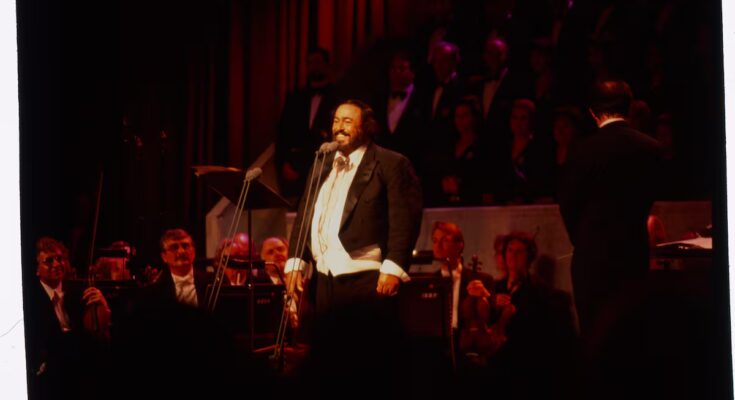Luciano Pavarotti was born in Modena in 1935, but had his first taste of success away from Italy, namely in Llangollen, a picturesque village in west Wales which still has an active steam train line. Pavarotti traveled to the village in July 1955 to take part in the Eisteddfod Male Choir Competition. He was 19 years old at the time and was a member of the Gioachino Rossini Choral Society of Modena, an amateur choir made up of workers from a car factory, office workers, students and his father Fernando, a baker and also an amateur tenor. “Dad, it’s impossible to sing better than us,” he told Fernando after the performance In Nomine Jesu by Jacobus Handl which earned him a gold medal. It was so hot in the tent where the final took place that when the jury’s decision was announced, the choir director fainted on stage.
Upon returning to Italy, Pavarotti abandoned his teacher training course and began the musical career that would transform him into one of the most famous tenors of the 20th century. He enrolled in singing lessons with Arrigo Pola and, in the 1960s, his own Rodolfo from La bohème he thrilled audiences at Covent Garden in London, La Scala in Milan (conducted by Herbert von Karajan) and the Met in New York. When journalists asked him about the most defining moment of his career, he recalled that competition in Wales: “I always tell journalists when they ask me what the most memorable day of my life is, and I always say it was when I won this competition.”
His long-awaited return to Llangollen finally took place in 1995, four decades later, accompanied by the Rossini Choir with his 83-year-old father in the front row and the BBC Philharmonic conducted by Leone Magiera. Cameras and 4,500 spectators gathered to see him in the Eisteddfod pavilion.
Pavarotti would have turned 90 on October 12, and to mark the anniversary, the Decca label recovered the original recording of that memorable comeback performance in 1995. “It all came about as a result of a conversation between a network producer and a record label consultant,” says Amy Greer, head of the label’s classical catalog. “We thought that the remastering of the concert, which has not been reissued or released commercially, had great symbolic value.”
The lost concert which was released today — includes arias, choruses and overtures from operas by Verdi and Puccini, among others, Neapolitan songs (such as O my sun), Welcome Hail Mary, sweet Mary with texts by Pavarotti himself, as well as the first known recordings of the tenor as a member of the Rossini Chorale during the 1955 competition: the Renaissance works of Orlando di Lasso Bonjour mon coeur and that of Handl In the name of Jesus.
It was customary for local families in the village to offer free accommodation to choirs from all corners of Europe. Pavarotti and his father, who did not speak a single word of English and did not know that a Welsh language existed, stayed at Alice Griffiths’ house. “I went to see them sing in Llangollen,” she told reporters. “They had wonderful voices, but I never thought that young man would become so famous.”
Curiously, among the guest artists of the Eisteddfod competition was the soprano Joan Sutherland, who would soon become an inseparable ally of Pavarotti in beautiful song operatic style, and the baritone Tito Gobbi, another of his references. “It’s clear that what he saw and heard encouraged him to follow in their footsteps,” Greer points out.
“Luciano often told me about that first trip to Wales,” recalls Nicoletta Mantovani, Pavarotti’s wife and mother of the youngest of Pavarotti’s four daughters. “It was an unforgettable and formative experience: he had never left post-war Italy and, suddenly, he found himself in an international competition, with different foods, habits and another language… Everything seemed new and fascinating to him”. Upon the choir’s return to Modena, a parade was held in their honor.
“He told me that if a small choir from a provincial town could win a world competition, perhaps he too could make a career out of it,” says Mantovani, adding that his family supported him from the beginning. “Luciano deeply admired his father,” he says. “They had a lot of fun during the Rossini Choral rehearsals. Fernando had an incredible voice, but he didn’t have the courage to sing alone. He once jokingly said to his son: ‘Can you imagine the career you would have had with my voice?'”
Since the singer’s death in 2007 from pancreatic cancer, Mantovani has managed his estate and overseen the management of the Casa Museo di Modena, which receives more than 50,000 visitors a year. “Luciano’s mission was to bring opera all over the world, that’s why he took the music out of the concert halls and performed in stadiums, squares and parks with pop stars,” says Mantovani. “He never ignored future generations: he taught for free, he wanted to give back the help he received and gave opportunities to young people. He always said that the decisive moment comes outside the classroom, when they have to deal with the public”.
Mantovani insists that Pavarotti would have liked to celebrate what would have been his 90th birthday “with another of his big surprise parties”, such as the masked ball created by Umberto Tirelli that she organized for his 70th. “He almost had a heart attack seeing so many friends together,” she says.
Pavarotti’s return to Wales in 1995 was not without complications. “Tibor Rudas (his manager at the time) had to be convinced and he inspected the facilities before approving the visit,” explains Greer.
By now Pavarotti was already a star: in addition to having conquered the temples of world opera, from San Francisco to the Paris Opera, he had also performed in front of the public in Hyde Park, he was one of the Three Tenors who emerged from the Baths of Caracalla in Rome and had appeared with Gloria Estefan, Mariah Carey, BB King, Sting and Bono.
«Who would have thought? No sleep would it reach number two on the pop charts and sell hundreds of thousands of copies? Nothing like this had happened before and it didn’t happen again,” says Greer. “It was the moment Pavarotti transcended opera and brought classical music to the general public.”
Sign up to our weekly newsletter to get more English-language news coverage from EL PAÍS USA Edition



